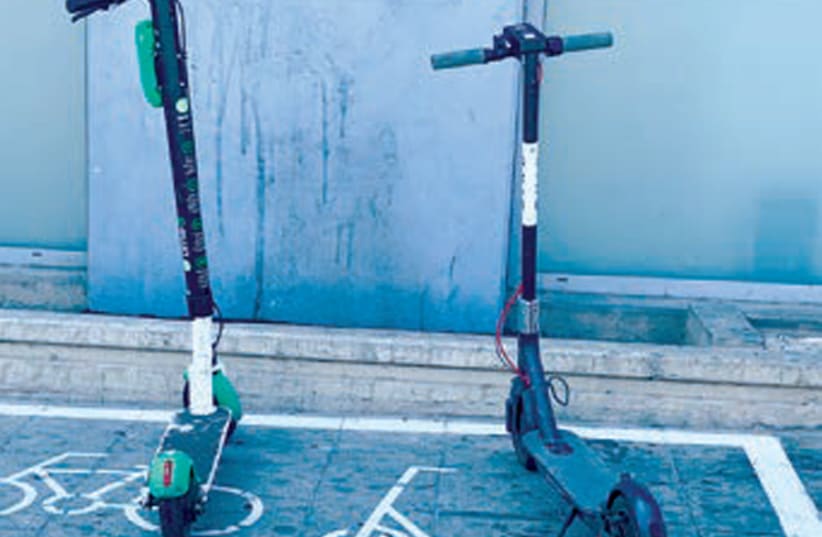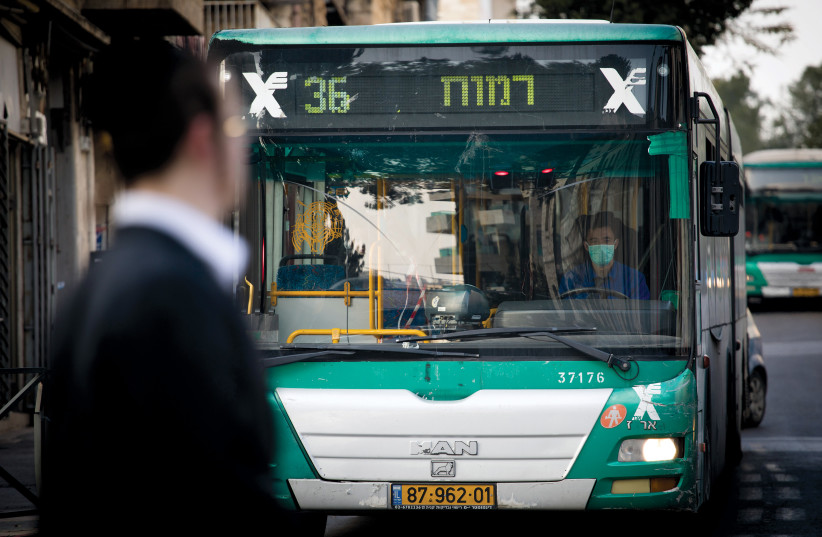IT’S NOT much fun being a Jerusalemite these days. Roadwork and construction sites all over the city are often impediments, not only to vehicular traffic, but also to pedestrians.
All of a sudden, bus routes are changed, because road works in certain places are being conducted on regular routes. Pavements are becoming increasingly dangerous for pedestrians as traffic police ignore vehicles on the pavement other than those which are illegally parked.
But bikes, scooters, electric wheelchairs and those small buggies that seat one to four people, depending on the size of the vehicle, and are actually mini-cars, which may be a partial solution to the paucity of parking lots, in that they take up less space, but they can go very fast, and do not rate police attention. Almost noiseless, they are very scary when they come up behind a pedestrian or skim by within grazing distance. They’re also far less expensive than a car. Originally intended for people with mobility problems, they are now purchased and used by able bodied individuals who see them as a boon, precisely because they can ride on the pavement to go shopping, sight-seeing or visiting, without anyone stopping them.
In fact, there are a couple of beggars in Jerusalem who own such vehicles and find it much more convenient, and possibly profitable, to ask for handouts from pedestrians, as they slow down alongside them. Their route is the length of Hebron Road, David Remez Street, Keren Hayesod Street and King George Street to Mahane Yehuda market via Agrippas Street or Jaffa Road, and back again after they’ve done their shopping, which they load on to the back of the vehicle. Owners of such vehicles drive through the market, much to the discomfort of other shoppers.
■ AS IF the above-mentioned situations are not bad enough, it can be really frustrating for bus passengers and drivers when the engine of a bus becomes problematic and the bus remains stationary. That’s what happened last Monday on the corner of Keren Hayesod Street and Ahad Ha’am Street.
A 34 bus stood by the traffic lights, which are right next to the bus stop going in the direction of Jaffa Road. More than half a dozen buses stood behind it, stretching all the way to the previous stop. The 78 bus, which was immediately behind it, tried to get past, but was prevented from doing so several times because buses were coming from the opposite direction. Because safety barriers have been erected along Keren Hayayesod, the bus could not move into the lane used by private cars, vans and trucks. Eventually, the road cleared sufficiently and the driver, having inched backwards and forwards, was eventually able to get past. But, then a strange thing happened: The engine of the 34 bus suddenly sprang to life and the bus surged past the 78 bus.
Go figure. A lot of angry passengers were relieved that they were finally moving, but all those with urgent appointments were late.
But that’s not nearly as bad as it’s going to be today, Friday, the annual day of torture for thousands of Jerusalemites who are not keen on the Jerusalem marathon, and who are either forced to do their Shabbat shopping on Thursday instead of Friday, when they prefer to buy fresh challah, fruits and vegetables, but cannot drive, or take public transport to the shops or the market. It’s also tough for pedestrians who might have to cross the road in order to reach their destinations, because staff working on behalf of the marathon will not allow them to do so, in case they interfere with the runners.
Certain areas along the route of the marathon were already closed to traffic late Thursday night. The rest of the route will be closed from 5.30.a.m. to 2 p.m. on Friday and includes Ben Zvi Boulevard, Rupin Boulevard, the Hebrew University Safra campus, Netanel Lorch, Rabin Boulevard, Haim Hazaz Boulevard, Tchernikovsky, Hapalmach, Gaza, Hanasi, Keren Hayesod, King George and Jaffa Streets, Tzahal Square, Hatzanhanim, Haim Bar Lev Boulevard, George Adam Smith, Lehi, Martin Buber, Binyamin Mazar, Churchill, Kariv, Jaffa Gate, the Armenian Patriarchate, Zion Gate, Hativat Yerushalayim, King David Street, Jabotinsky, Chopin, Dubnov, Gretz, Emek Refaim, Derech Harakevet, Derech Beit Lechem, David Remez, Hebron, Yanovsky, Yehuda, Piere Koenig, Elazar Hamodai, Kovshei Katamon, Yehoshua Yavin and Sacher Park.
Just think of how many people live in or adjacent to these streets, and who have to readjust their schedules to fit in with the marathon. A close look at the above indicates that the residents of Mea Shearim, Geulah, Givat Shaul, Romema and other religious neighborhoods will not be disturbed. One can’t help wondering whether this is because of the high ratio of haredi members of the City Council.
■ THE MAJOR ongoing inconvenience, which began this week and will continue till the end of the month, is the completion of the entrance to Jerusalem, which means that traffic will have to be diverted and there will be chaos, confusion and congestion on the already overcrowded routes that traffic will be permitted. All this, just as tourism is beginning to pick up again, as well as in-person events, such as conferences, gala dinners, weddings, and so on. Why could work not have been sped up during the height of the pandemic when hotels and banquet halls were closed? With all this and more to create anger and annoyance in the city, it’s highly doubtful that Mayor Moshe Lion will be the flavor of the month.
■ THE FENCE boards that were erected around France Square while it was being renovated and enlarged have come down. The fountain is not as pretty as it used to be and is now completely in that shade of dull green that one sees on the patina of copper that has been exposed to the elements as it ages. There are benches, flower beds that surround trees and several trees planted on a grass embankment, but the area lacks the intimacy that was there before, especially with regard to demonstrations. A large flower bed separates demonstrators from passers-by in the street, whereas in the past, they could easily engage in conversation. It is fairly obvious that the facelift of France Square required a generous budget. Yet with all the money and effort that was invested in the project, no one thought to include a public toilet.
■ FOOD INSECURITY – The Continuing Pandemic: Toward Sustainable Food Systems for Israel is the title of an international day-long conference hosted by the Jerusalem-based Israel Academy of Sciences and Humanities. The conference is open to the public and will begin at 9:30 a.m. on Thursday, March 31 at the Academy, 43 Jabotinsky St., Jerusalem. Sessions will include Food Security on the National Agenda; Approach to Food and Nutrition Security, Transforming toward sustainable food systems; and The Politics and Economics of Food Security.
Among the speakers will be Prof. Elliott Berry and Prof. Chaim Cedar of the Hebrew University, Minister for the Protection of the Environment Tamar Zandberg, Prof. Dan Glickman, former US Secretary of Agriculture Prof. Valerie Tarusuk of the University of Toronto, Prof. Martin Cartaher of the University of London, Prof. Philp Howard of Michigan State University and many other experts from Israel and abroad. Admission is free, but advance registration is required. The conference will also be broadcast on the Academy’s website at www.academy.ac.il.
greerfc@gmail.com

